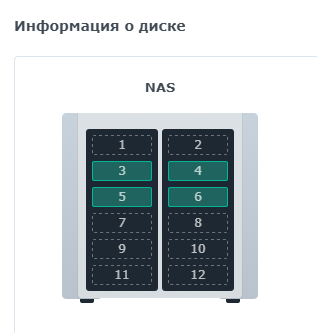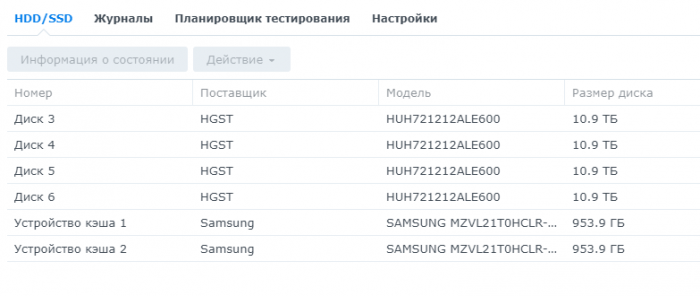
alex.god007
-
Posts
21 -
Joined
-
Last visited
Posts posted by alex.god007
-
-
In folder
/etc/sysconfig/network-scripts
i've created ifcfg-eth2 config that is the same for ifcfg-eth1 except device and brigde name:
ash-4.4# cat ifcfg-eth2 DEVICE=eth2 BOOTPROTO=dhcp ONBOOT=yes BRIDGE=ovs_eth2
then restarted network services with/etc/rc.network restart
and both 10 gigabit interfaces are up and running:
I hope that these setting wouldn't reset after reboot 😃
-
1 hour ago, flyride said:
Add maxlanport=4 or whatever you need in user_config.json and TCRP will patch it on bootup.
Still no luck. I've seen that only 2 interfaces are up and running.

At synoinfo.conf I've updated option to 4:
maxlanport="4"
In grub.conf I see netif_num option and needed MAC addresses:
Maybe I'm missing something? Or should I move to another platform one more time ?

-
By the way: it is possible to add one more MAC address to user_config.json file to enable one more port on 10 gigabit NIC? my.sh finds that there are more than one NIC in system and generates mac for second port, but script doesn't get info that there are 2 ports in that second NIC
What are the proper steps to update settings and apply them to the current installation?
Should I boot up to Linux and use postupdate option after making changes in user_config.json ?
-
7 hours ago, flyride said:
That only works with DS3622xs+
Patch the lib file with your PCI addresses.
https://xpenology.com/forum/topic/13342-nvme-cache-support/?do=findComment&comment=217008
Thank you so much - it works!
Finally, M.2 SSDs are showed, and now I can enable cache with them!
-
2 hours ago, flyride said:
Your idea of upgrade on another platform will probably work.
I've made all the things and loaded up with platform 918+. SATA disks are visible and array is in normal state. But there is no cache devices in Disk manager.
I've checked system output and there are an NVMe devices :
akoznov@NAS:~$ udevadm info /dev/nvme0n1 P: /devices/pci0000:00/0000:00:1b.4/0000:04:00.0/nvme/nvme0/nvme0n1 N: nvme0n1 E: DEVNAME=/dev/nvme0n1 E: DEVPATH=/devices/pci0000:00/0000:00:1b.4/0000:04:00.0/nvme/nvme0/nvme0n1 E: DEVTYPE=disk E: MAJOR=259 E: MINOR=0 E: PHYSDEVBUS=pci E: PHYSDEVDRIVER=nvme E: PHYSDEVPATH=/devices/pci0000:00/0000:00:1b.4/0000:04:00.0 E: SUBSYSTEM=block E: SYNO_ATTR_SERIAL=S64PNF0R705302 E: SYNO_DEV_DISKPORTTYPE=UNKNOWN E: SYNO_INFO_PLATFORM_NAME=apollolake E: SYNO_KERNEL_VERSION=4.4 E: SYNO_SUPPORT_XA=no E: TAGS=:systemd: E: USEC_INITIALIZED=986445 akoznov@NAS:~$ akoznov@NAS:~$ udevadm info /dev/nvme1n1 P: /devices/pci0000:00/0000:00:1d.0/0000:07:00.0/nvme/nvme1/nvme1n1 N: nvme1n1 E: DEVNAME=/dev/nvme1n1 E: DEVPATH=/devices/pci0000:00/0000:00:1d.0/0000:07:00.0/nvme/nvme1/nvme1n1 E: DEVTYPE=disk E: MAJOR=259 E: MINOR=1 E: PHYSDEVBUS=pci E: PHYSDEVDRIVER=nvme E: PHYSDEVPATH=/devices/pci0000:00/0000:00:1d.0/0000:07:00.0 E: SUBSYSTEM=block E: SYNO_ATTR_SERIAL=S64PNF0R705285 E: SYNO_DEV_DISKPORTTYPE=UNKNOWN E: SYNO_INFO_PLATFORM_NAME=apollolake E: SYNO_KERNEL_VERSION=4.4 E: SYNO_SUPPORT_XA=no E: TAGS=:systemd: E: USEC_INITIALIZED=986883
Also I've created /etc.defaults/extensionPorts file and there is no luck after reboot:
cat /etc.defaults/extensionPorts [pci] pci1="0000:00:1b.4" pci2="0000:00:1d.0"
Any ideas?
-
 1
1
-
-
2 minutes ago, flyride said:
The DUMMY responses indicate that the motherboard has dual-use M.2 ports. They can support SATA SSD's or NVMe.
Any SATA port that is not configured for "hotplug" is disabled by the kernel. Any disabled port results in a DSM installation failure.
The dual use ports have no BIOS provision for hotplug. Thus there is no easy fix.
Your idea of upgrade on another platform will probably work. There are a few other options you might consider that are outlined in the tutorial.
However, I strongly suggest you remove the SSD cache prior to ANY upgrade or migration, and then add it back in afterward.
Thanks mate! Going to rebuild it, migrate current platform from DS3615xs to 920+ and then rebuild it with new motherboard. Will write down after I'll finish those operations.
-
5 minutes ago, flyride said:
I cannot read the Russian image, but I suspect you have a motherboard that is exhibiting a problem we don't fully have a solution for.
From TinyCore, please post the result of
dmesg | grep "DUMMY"And we can advise further.
Yeah, I think so.
tc@box:~$ dmesg | grep "DUMMY"
[ 0.270826] ata1: DUMMY
[ 0.270827] ata2: DUMMY
tc@box:~$
I think that is the problem that using M.2 PCI-E SSDs are using ATA1/2 ports and installation cannot be proceeded. I cannot disable SATA on M.2 - there is no option in BIOS.I have a really weird plan - maybe it will work? I can rebuild back NAS with old motherboard on Z270 chipset via ASRock mini itx z270 with 6 SATA ports in it and connect to them 4 disks + 2 SATA SSDs (that was used as SSD Cache). Then I'll create a new installation and try to migrate data. If it will be OK - I'll switch back to new motherboard with connected M.2 SSDs in it and loaded to needed platform with m.2 modules in it. Should it work?
-
14 minutes ago, flyride said:
Of all the supported platforms, DS3615xs is the only one that does not support NVMe on DSM 7.x.
https://xpenology.com/forum/topic/61634-dsm-7x-loaders-and-platforms/
Thanks for info. I was trying to create a new USB drive with 918+ loader with the same settings (except USB PID/VID + new generated S/N with MAC) but I'm getting only message that there are no disks in system.
Using sataportmap in installation giving me an error that there is an error with disks 1 and 2.
Really don't want to lose data that was created during DS3615xs installation and don't know what next steps I should do further with detecting disks on new platform 😃
In fresh env of tinycore here is output of devices. Currently there is no ata1 and ata2 (only 4 SATA ports on this motherboard):
lrwxrwxrwx 1 root root 0 Jun 5 16:40 sda -> ../devices/pci0000:00/0000:00:17.0/ata3/host2/target2:0:0/2:0:0:0/block/sda
lrwxrwxrwx 1 root root 0 Jun 5 16:40 sdb -> ../devices/pci0000:00/0000:00:17.0/ata4/host3/target3:0:0/3:0:0:0/block/sdb
lrwxrwxrwx 1 root root 0 Jun 5 16:40 sdc -> ../devices/pci0000:00/0000:00:17.0/ata5/host4/target4:0:0/4:0:0:0/block/sdc
lrwxrwxrwx 1 root root 0 Jun 5 16:40 sdd -> ../devices/pci0000:00/0000:00:17.0/ata6/host5/target5:0:0/5:0:0:0/block/sdd
lrwxrwxrwx 1 root root 0 Jun 5 16:40 nvme0n1 -> ../devices/pci0000:00/0000:00:1b.4/0000:04:00.0/nvme/nvme0/nvme0n1
lrwxrwxrwx 1 root root 0 Jun 5 16:40 nvme1n1 -> ../devices/pci0000:00/0000:00:1d.0/0000:07:00.0/nvme/nvme1/nvme1n1
-
23 minutes ago, neonflx said:
you can try this , it worked for me identifying the nvme after moving them,
if you already have a pci1 listed then just start at pci2,3 etc
udevadm info /dev/nvme0n1
udevadm info /dev/nvme1n1
sudo vi /etc.defaults/extensionPorts
Add:
[pci]
pci1="0000:00:1b.0"
pci2="0000:00:1d.0"Problem that there is no nvme devices in /dev =( Maybe there is no support for nvme drives in DS3615xs. As official site said only couple of models supports built-in M.2 SSDs:
-
Hello everyone!
Can I get an answer about adding M.2 SSD as cache for XPEnology?
I was having a motherboard with one M.2 slot (ASRock mini itx z270) but with 6 SATA ports on board. I've changed it to ASUS strix x270i with two M.2 slots in it. I've swapped all components, include USB flash with Redpill based on Tinycore Redpill v0.4.6 with Model DS3615xs and FW: Bromolow DSM 7.0.1-42218 Update 2 (options in user properties file:
"SataPortMap": "58",
"DiskIdxMap": "0A00"System loads up correctly, but M.2 SSDs are not showed up.

It is possible that M.2 disks are not showing in case of using DS3615xs model of bootloader and should I switch to DS918+ or DS920+ model of redpill bootloader?
If yes - what type of options in user properties file should I use to get M.2 and SATA drives up and running without losing data of HDDs? 😃
Thanks!
-
Добрый день.
Подскжите пожалуйста, ставлю dsm 6.1-15047 ds3615 - все отлично, пытаюсь утановить ds3617 - установка прерывается на 56% с ошибкой 13 (возможно поврежден файл). пытался и вручную и онлайн скачивать pat, результат один - ошибка
загрузчик 1.02а
PID/VID флешки верные выставил?
Вот что пишет разраб по этому поводу:
"Note 3: Please check you have the right VID/PID prior proceeding. If you get the following error ”Failed to install the file. The file is probably corrupted. (13)" it means your VID and/or PID is wrong. If you are 200% sure that your VID/PID is correct and you still get that error message then try to 'Force Install'."
-
Hello, i've got some issues with internet access for my synology installation on microserver g7.
By instruction create flash with synology, change PID/VID, generate SN which was accepted in account.synology.com, regenerate MAC and succesfully installed on Microserver g7. Next few hours all was work right (i've installed letsencrypt cert via web) and after 2-3 hours internet is gone. No network access to external network (internet).
In network setting nothing changes , another hosts are working well. I cant install any package via package manager.
What's can be problem? Maybe in SN? I've made login in synology to portal synology and add quickconnect settings.
Thanks in advance.
-
Коллеги, подскажите пожалуйста :
По инструкции создал флешку, заменил PID/VID, подобрал SN который успешно принялся на сайте account.synology.com, сгенерировал MAC и успешно все установил на Microserver g7. Далее несколько часов все работало корректно, даже успел через letsencrypt сгенерировать сертификат, а после как-будто пропал интернет на сервере.
В рамках ЛВС ничего не изменялось, на остальных хостах системы все работает корректно. Соответственно никаких пакетов не могу ставить.
Подскажите в чем может быть проблема? может ли быть проблема в серийнике? производил вход в аккаунт с установленой системы на g7.
-
Приветствую!
Есть Microserver G7, на борту стоит VMWare Esxi 5.5 , в ней виртуалка с загрузочным диском xpenology gnoboot-alpha.
Сейчас стоит версия 5.0-4458 update 2, хочу обновить до последней 4493 update 7. Делаю по инструкции (по 2м вариантам) - загружаю пакет через веб морду, в консоли через sed заменяю вхождения и муваю файл:
sed 's/flashupdateDeb/flashupdateDeb1/' /autoupd@te.info > /autoupd@te.info1
mv /autoupd@te.info1 /autoupd@te.info
тыкаю обновить - он валится с ошибкой "обнаружена неизвестная ошибка (21)"
В чем может быть проблема?
-
I can't seem to get PLEX to work properly.
Any of you guys have the same prob?
Cheers and thanks!
Hello!
What kind of problems with Plex on XPEnology are you have?
I'm using latest version of XPEnology DS3612xs on HP MicroServer G7 - all right.
Thanks!
-
Probably I made all I want.
I've installed ESXi 5.5 on HP Microserver Gen7 on my 40 Gb SSD. After that I create virtualmachine with XPEnology using converted gnoboot-alpha10.5-ext2.img into VMDK (converted VMDK you can download using next link http://yadi.sk/d/oumBLqLIMvzAF).
I've created VM with next preferences:
CPU - 2
Memory - 4Gb
SCSI Controller 0 - LSI Logic Parallel
Network adapter - VM Network (E1000)
Hard Disk 1 - 32 Mb (Converted IMG to VMDK) - IDE (0:0)
Hard Disk 2 - 5 Gb (For installing XPEnology) - SCSI (0:0)
After that I started VM, installed XPEnology and shutdown it.
The most interesting part

If you want to have good enough speed of your NAS disks we should try Mapped RAW Lun type connection if Disks (RDM).
I've got 3x2Tb WD Red disks and we will use them as storage disks in XPEnology. Before using them into RDM lets delete all partitions from disks.
To made this we should list all connected disks to system using this command on ESXi server via ssh:
ls -l /vmfs/devices/disks/
Finally we have got id's of disks, that will be used in RAID on XPEnology. Lets delete all partitions on disks (for example):
fdisk /vmfs/devices/disks/t10.ATA_____Hitachi_HDS721010CLA332_______________________JP2950HZ0E47HC
Press 'O' to create new partition table and 'W" to apply changes.
Repeat this article on another disks. Do not touch system disk if you dont want to have some troubles

Lets move to directory with VM, which will be connected with RDM disks. In this direcrory will be created VMDK files of these disks.
cd /vmfs/volumes//
In step before we found id's of disks that will be used in RDM (t10.ATA_____Hitachi_HDS721010CLA332_______________________JP2950HZ0E47HC etc.)
Let's create RDM VMDK file:
vmkfstools -r /vmfs/devices/disks/ NAS1.vmdk
for example:
vmkfstools -r /vmfs/devices/disks/t10.ATA_____Hitachi_HDS721010CLA332_______________________JP2950HZ0E47HC NAS1.vmdk
In VmWare client add disks to virtual machine as an existent virtual disk.
In RAID-0 of 2 disks I've got over 105 Mbps in gigabyte link. Now I'm building RAID-5 with 3x2Tb disks. About results I will get updated information.
Information about RDM was found here: http://chmv.allnetic.com/article/vmware ... a-kak-rdm/ (Russian Language
 ).
).Thanks for your attention.
-
Guys, is there anybody who has made work XPEnology on ESXi with normal speeds? If yes - what type of controller in VMWare are you using and what about specific setiings?
Thanks!
-
At beginning over 60 Mbs, after that it go lower to 5 Mbs. If I install XPEnology as real OS on my disk speed of copying files into Microserver over 110 Mbs.
I got same results. I found out that the RDM solution makes the access to HDD much slower comparing to the VMDK-drive. In random places in this forum, I read similar results.
Currently, I decided to use XPEnology on the real device, but spend the smallest drive for ESXi needs.
Today, I've installed ProxMox and install XPEnology in virtualmachine - I've got about 40-45 Mbs in writing on disk.
Thats much better, but i will search more to have good result. Maybe try Citrix Xen Server?
-
Hello!
I've installed XPEnology gnoBoot on my HP Microserver G7 N54 over ESXi 5.
All right, but my speed of copying on XPEnology is very slow (at beginning over 60 Mbs, after that it go lower to 5 Mbs). If I install XPEnology as real OS on my disk speed of copying files into Microserver over 110 Mbs.
If you have got same scheme can you provide me your speed.
At this moment I will try installing another hypervisor (Proxmox) and test XPEnology on it.
Can it be some troubles with configuration of ESXi and problem can be solved by fixing it ?
Thanks!






TinyCore RedPill Loader (TCRP)
in Loaders
Posted
Nope, I just changed the config and rebooted. Should I use standard ./rploader.sh build syntax to update loader?